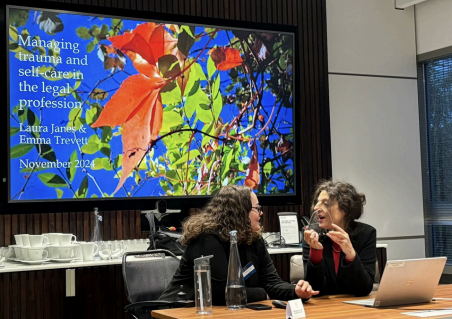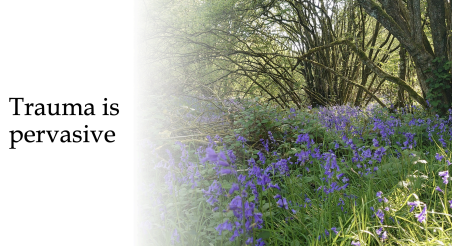18 November 2024
By Laura Janes, Consultant Solicitor, GT Stewart and Scott-Moncrieff and LAPG; Emma Trevett, Solicitor, Lawstop and YLAL

Being a lawyer in legal aid and advice work has many pressures. As Joanna Fleck and Rachel Francis say in their book, Vicarious Trauma in the Legal Profession: a practical guide to trauma, burnout and collective care:
“Lawyers working in legal aid, social justice or with survivors of injury regularly work with traumatic and emotionally potent caseloads and often draw on skills for which they have had no formal training.
They bear witness to the pain of clients, to the suffering that humans inflict upon each other, and to the incredible strength of survivors of violence, torture and abuse.
They do this while dealing with the financial pressure of poor rates of pay, constantly overstretched resources and a relentlessly hostile political environment.”
Rachel and Joanna, who were previously committee members for Young Legal Aid Lawyers, now run an organisation called Claiming Space which provides support to lawyers in the sector.
While awareness of the risk of vicarious trauma is much greater now, partly thanks to champions such as Rachel and Joanna and organisations such as Law Care, it still feels as though the profession is getting to grips with how to grapple with the issue as part of routine practice management.
This much was clear from the number of practitioners who attended our session on the topic at the LAPG conference on Friday 8 November 2024: attendees included students, aspiring lawyers, paralegals, lawyers and partners from private firms and charitable organisations. The strong sense was that stress and trauma is pervasive, whether from exposure in our work, the stress of deadlines and legal aid bureaucracy or as a result of our own health and well-being issues.
As Laura has previously written about, legal processes are often traumatic in themselves. Judith Harman has observed
“if one set out intentionally to design a system for provoking symptoms of traumatic stress, it might look very much like a court of law”.
The court set up includes so many anxiety-provoking elements, intense scrutiny by strangers, sometimes in public, hierarchy, enormous consequences and important deadlines.

Despite this, practitioners told us that so many people just feel as though they have to “muddle through”, being expected to deal with exposure to endless distressing issues, supporting colleagues, dealing with aggressive litigants in person and opponents and going through personal issues from physical and mental health issues, including serious illness, (peri)menopause and bereavement. Burnout is a constant risk both for individuals and firms and organisations wanting to invest and retain staff.
All too often, as Emma’s own experience shows, it takes a monumental life event to encourage a change in practice. Emma talked powerfully about her experience of having a stroke back in 2020 and how that forced her to rethink her approach to self-care.
Drawing on her experiences she provided top tips and guidance including:
- Sleep – How to have a good sleep routine
- Rest – How to rest effectively according to demand type
- Meditation/Mindfulness – An introduction to starting practice
- Journalling – How journalling can help you to explore thoughts and feelings
- Words of Wisdom (maybe) – A few tips from my personal experience
This event was the first time since her stroke that Emma had come to London and spoken publicly about her experiences in person, sharing what she has learned to encourage others to take urgent practical steps towards self-care.
The session provided a space for practitioners to share and discuss ideas with each other, on how to best support clients and lawyers in our often painful and difficult work.

Here are some of the ideas that emerged in the workshop discussion:
Supporting clients
- Make sure your clients feel heard and listened to
- Signpost to local community resources – what support can the sector get in
identifying appropriate places to signpost to? - Sensitive and clear communication for clients: some practitioners create packs for vulnerable clients with pictures about who the people are in thecase, what the court looks like etc. The organisation, Rights of Women, provides some excellent information for clients. Could lawyers be better supported with resources to be able to pick and choose images and easy read items to include in bespoke letters?
- Ask the client how they prefer to communicate – i.e. whether they prefer email, calls or in person meetings?
- Create the illusion of time/make time to deal with the case as you find it and never sound “too busy” to give your client the time and attention they need: where appropriate, justifying reaching the escape fee
- Familiarise yourself with the trauma and the brain video which provides a neurological explanation of how and why we react in certain ways to stress and use this evidence in your discussions and submissions with clients and the court
- Remembering that looking after yourself is an act of care for your clients
Supporting lawyers
- Keep on talking – communication among ourselves is important
- Give ourselves permission to speak about own experiences – encourage
open discussion, especially by senior lawyers so that junior lawyers feel able
to discuss their concerns openly - Use resources – for example Helen Bamber foundation’s trauma informed
code of conduct - Look after yourself, your colleagues and your staff
- Make time for what you love whether that is running, baking, walking or
reading - Be careful about how you manage work and set realistic goals i.e. top 3 most
important tasks - Swap files to share difficult issues
- Co-work
Further resources
- Trauma informed training, Law Society, Scotland
- Searching for serenity
- People, not just books: An Investigation into the Knowledge and Understanding of Trauma Informed Practice in The Justice System by Dr
Catherine O’Neill - Trauma informed lawyering, YJLC
- A trauma informed court system/support for jurors by Dr Hannah Fawcett
We would like to extend our thanks to Sian Hukin of Reeds Solicitors and YLAL for taking a note of this session for us.